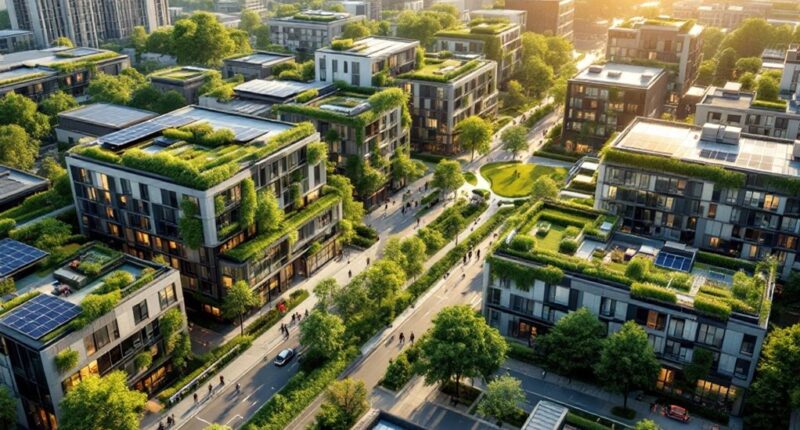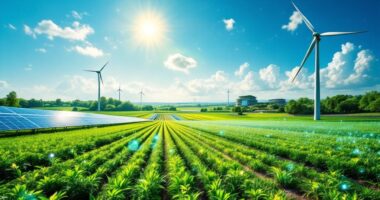Urban sustainability transforms cities into environmentally sound havens by balancing social equity, economic viability, and ecological protection. These metropolitan areas feature compact neighborhoods, biophilic design elements, and vibrant public spaces that foster community connections. Smart policies, public-private partnerships, and local economic initiatives drive implementation despite retrofitting challenges and resistance to change. The payoffs extend beyond energy savings to include stronger communities, improved quality of life, and climate resilience. The journey toward greener cities reveals surprising benefits at every corner.

Urban Sustainability
While cities have traditionally been associated with pollution and resource depletion, urban sustainability represents a revolutionary approach to creating thriving metropolitan areas that can flourish indefinitely. The concept is like a three-legged stool, balancing social equity, economic viability, and environmental protection—knock one leg out, and the whole thing topples over faster than a house of cards in a windstorm.
At its core, sustainable urban development focuses on creating compact, walkable neighborhoods where everything you need is within reach. Imagine rolling out of bed and having your coffee shop, grocery store, and workplace all within a pleasant stroll—no traffic jams, no road rage, just you and your reusable coffee mug taking on the day. These mixed-use areas don’t just save time; they slash carbon emissions too. Sustainable urbanism promotes biophilic design that integrates natural elements into urban environments, enhancing well-being and ecological health.
The economic payoffs of sustainable cities aren’t just feel-good bonuses—they’re serious business. Green buildings might cost a smidge more upfront (like buying quality shoes instead of the bargain bin specials), but the long-term savings in energy costs make bean counters do happy dances. Plus, sustainable cities become talent magnets, attracting innovative companies and the workforce of tomorrow. Creating local economies that prioritize community needs helps reduce dependency on global supply chains while fostering neighborhood resilience.
Social benefits abound in these green urban centers. When people bump into each other in parks or community gardens, social bonds form naturally. It’s like social media, but with actual face-to-face interaction—revolutionary, right? These connections build community resilience that proves invaluable during challenges. The critical thinking demonstrated in neighborhood analysis helps identify appropriate sustainability strategies tailored to specific community needs.
Implementation requires a cocktail of smart policies—building codes with teeth, renewable energy investments, and incentives that make going green the easy choice. Public-private partnerships act as the secret sauce, bringing together government vision with private sector muscle.
Of course, challenges remain. Retrofitting existing urban dinosaurs for sustainability isn’t easy, and keeping neighborhoods affordable while making them more desirable requires finesse. But as climate change knocks louder on our door, the path toward urban sustainability isn’t just desirable—it’s becoming the only sensible way forward.
Frequently Asked Questions
How Do Urban Sustainability Efforts Impact Property Values?
Urban sustainability efforts considerably boost property values.
Homes near parks and green spaces see value increases of 8-20%, with properties within 1/4 mile of protected open spaces gaining over $13,000 on average.
Green-certified buildings command higher rents due to reduced utility costs.
However, impact varies based on park maintenance, size, and accessibility.
While sustainable features may have higher upfront costs, they typically lead to increased economic growth, property tax revenues, and neighborhood revitalization.
Can Sustainable Practices Reduce Crime Rates in Cities?
Evidence shows sustainable urban practices profoundly impact crime reduction.
Greening vacant lots can decrease violent crime by 30%, while enhancing street lighting reduces nighttime crimes by 36%.
Community-based initiatives like gardens and neighborhood improvement projects strengthen social connections, reducing assault rates by up to 40%.
Urban greening efforts correlate with substantial homicide reductions over time.
These interventions work by improving territorial awareness, natural surveillance, and creating spaces where communities gather safely—transforming once-troubled areas into vibrant, crime-resistant neighborhoods.
What Career Opportunities Exist in Urban Sustainability?
Urban sustainability offers diverse career paths for eco-minded professionals. The field has experienced explosive growth, with green jobs increasing at twice the rate of overall employment.
Opportunities range from urban planners and sustainability consultants to renewable energy specialists and green building architects. Emerging roles include climate resilience managers and smart city technology specialists.
The field rewards interdisciplinary knowledge, data analysis skills, and strong communication abilities. Women currently dominate the sector, representing 64% of sustainability professionals.
How Does Cultural Diversity Influence Sustainable Urban Planning?
Cultural diversity profoundly shapes sustainable urban planning by influencing how spaces function and feel.
When planners incorporate diverse cultural perspectives, cities develop more inclusive public spaces, culturally sensitive housing, and transportation systems that serve varied needs. This approach prevents gentrification while preserving heritage sites and architectural uniqueness.
Cities that embrace cultural diversity typically show greater resilience, economic dynamism, and social cohesion—essentially becoming living ecosystems where different traditions coexist and enrich sustainable urban solutions.
Are Sustainable Cities More Resilient to Economic Downturns?
Evidence suggests sustainable cities demonstrate greater economic resilience during downturns. Their diversified economies, particularly green sectors like renewable energy, tend to weather financial storms more effectively.
Resource efficiency measures reduce operational costs for businesses and households alike. Additionally, strong social cohesion networks provide informal safety nets.
The adaptive capacity built into sustainable urban systems—including flexible infrastructure and data-driven technologies—allows for quicker pivoting when economic conditions change, creating multi-layered protection against fiscal shocks.









